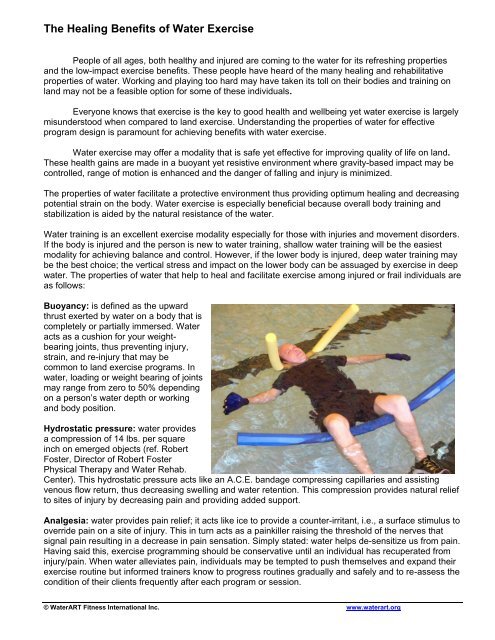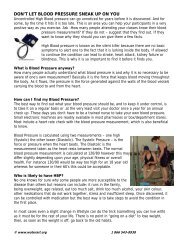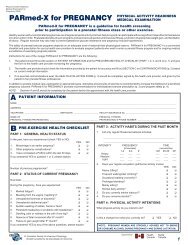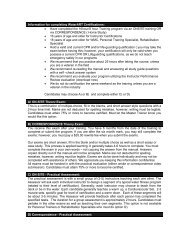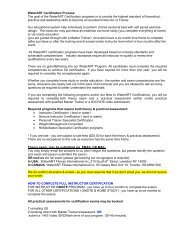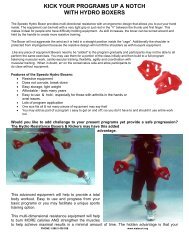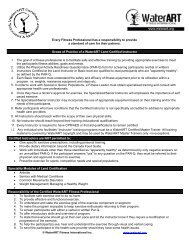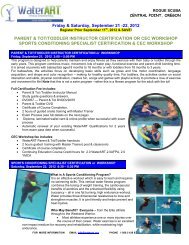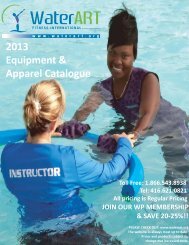The Healing Properties of Water Exercise (PDF) - WaterART Fitness ...
The Healing Properties of Water Exercise (PDF) - WaterART Fitness ...
The Healing Properties of Water Exercise (PDF) - WaterART Fitness ...
Create successful ePaper yourself
Turn your PDF publications into a flip-book with our unique Google optimized e-Paper software.
<strong>The</strong> <strong>Healing</strong> Benefits <strong>of</strong> <strong>Water</strong> <strong>Exercise</strong><br />
People <strong>of</strong> all ages, both healthy and injured are coming to the water for its refreshing properties<br />
and the low-impact exercise benefits. <strong>The</strong>se people have heard <strong>of</strong> the many healing and rehabilitative<br />
properties <strong>of</strong> water. Working and playing too hard may have taken its toll on their bodies and training on<br />
land may not be a feasible option for some <strong>of</strong> these individuals.<br />
Everyone knows that exercise is the key to good health and wellbeing yet water exercise is largely<br />
misunderstood when compared to land exercise. Understanding the properties <strong>of</strong> water for effective<br />
program design is paramount for achieving benefits with water exercise.<br />
<strong>Water</strong> exercise may <strong>of</strong>fer a modality that is safe yet effective for improving quality <strong>of</strong> life on land.<br />
<strong>The</strong>se health gains are made in a buoyant yet resistive environment where gravity-based impact may be<br />
controlled, range <strong>of</strong> motion is enhanced and the danger <strong>of</strong> falling and injury is minimized.<br />
<strong>The</strong> properties <strong>of</strong> water facilitate a protective environment thus providing optimum healing and decreasing<br />
potential strain on the body. <strong>Water</strong> exercise is especially beneficial because overall body training and<br />
stabilization is aided by the natural resistance <strong>of</strong> the water.<br />
<strong>Water</strong> training is an excellent exercise modality especially for those with injuries and movement disorders.<br />
If the body is injured and the person is new to water training, shallow water training will be the easiest<br />
modality for achieving balance and control. However, if the lower body is injured, deep water training may<br />
be the best choice; the vertical stress and impact on the lower body can be assuaged by exercise in deep<br />
water. <strong>The</strong> properties <strong>of</strong> water that help to heal and facilitate exercise among injured or frail individuals are<br />
as follows:<br />
Buoyancy: is defined as the upward<br />
thrust exerted by water on a body that is<br />
completely or partially immersed. <strong>Water</strong><br />
acts as a cushion for your weightbearing<br />
joints, thus preventing injury,<br />
strain, and re-injury that may be<br />
common to land exercise programs. In<br />
water, loading or weight bearing <strong>of</strong> joints<br />
may range from zero to 50% depending<br />
on a person’s water depth or working<br />
and body position.<br />
Hydrostatic pressure: water provides<br />
a compression <strong>of</strong> 14 lbs. per square<br />
inch on emerged objects (ref. Robert<br />
Foster, Director <strong>of</strong> Robert Foster<br />
Physical <strong>The</strong>rapy and <strong>Water</strong> Rehab.<br />
Center). This hydrostatic pressure acts like an A.C.E. bandage compressing capillaries and assisting<br />
venous flow return, thus decreasing swelling and water retention. This compression provides natural relief<br />
to sites <strong>of</strong> injury by decreasing pain and providing added support.<br />
Analgesia: water provides pain relief; it acts like ice to provide a counter-irritant, i.e., a surface stimulus to<br />
override pain on a site <strong>of</strong> injury. This in turn acts as a painkiller raising the threshold <strong>of</strong> the nerves that<br />
signal pain resulting in a decrease in pain sensation. Simply stated: water helps de-sensitize us from pain.<br />
Having said this, exercise programming should be conservative until an individual has recuperated from<br />
injury/pain. When water alleviates pain, individuals may be tempted to push themselves and expand their<br />
exercise routine but informed trainers know to progress routines gradually and safely and to re-assess the<br />
condition <strong>of</strong> their clients frequently after each program or session.<br />
© <strong>Water</strong>ART <strong>Fitness</strong> International Inc. www.waterart.org
Resistance: in the water is, in effect, a natural 3-dimensional weight training machine that is instantly<br />
adjustable, i.e. the harder an athlete pushes and pulls, the more resistance will be achieved. <strong>Water</strong>specific<br />
equipment may exponentially increase the surface area and drag to add intensity and load to any<br />
movement. Buoyancy equipment may add complexity to the exercise because a joint may easily go<br />
beyond normal range <strong>of</strong> motion with speed or lack <strong>of</strong> control.<br />
Loading the Joints: in shallow water exercises, i.e. when an<br />
individual’s feet are touching the pool floor, results in loading the joint<br />
or weight bearing so that there may be up to 50% gravity or vertical<br />
stress on the joints. Rebounding and lower body squats for<br />
strengthening are important exercises to be programmed in this water<br />
depth. Often, in deep water, the quadriceps muscles may be difficult<br />
to effectively work or load without advanced drag equipment such as<br />
fins, cuffs or resistive kickers (or even shoes). Everyone needs to<br />
strengthen the lower body to move the body for functional<br />
independent life on land. An athlete may gradually load the joints by<br />
starting in deep water, then going to neck depth (10% <strong>of</strong> body weight),<br />
then to chest (25% <strong>of</strong> body weight) and finally working at waist depth<br />
(50% <strong>of</strong> body weight) prior to returning to their land activity or sport.<br />
Unloading the Joints: or working in a suspended body position will result in unloading the joint or nonweight<br />
bearing <strong>of</strong> the joint so there is minimal gravity or vertical stress on the joints. <strong>The</strong>re is still an<br />
opportunity for muscular function, strength and balance; and an individual will require core strength for<br />
balance and to optimally support their movements. <strong>The</strong>refore, without bottom contact, the client will<br />
require more skills and individual attention to maintain correct body alignment and quality technique. Using<br />
the appropriate buoyancy equipment to balance their body posture may make or break their results.<br />
Buoyancy belts, noodles, cuffs or dumbbells must balance the<br />
person’s body compositions so that the head may stay above<br />
the water with the shoulders as much submerged and<br />
protected as possible. <strong>The</strong> body should be able to hang<br />
vertically without falling forward, backwards or sideways due<br />
to an imbalance <strong>of</strong> their body composition. Generally men<br />
have more chest buoyancy whereas women have more hip<br />
body fat and therefore tend to tilt forward. A buoyancy belt that<br />
has too much lumbar support may easily tilt a very buoyant<br />
lady forward and negate any postural benefits that the water<br />
may <strong>of</strong>fer. It is important for trainers to be aware <strong>of</strong> not only<br />
the most effective programming for water fitness, but also the<br />
most effective equipment to maximize their clients’ benefits<br />
from water exercise.<br />
<strong>Water</strong> programs, whether they are one-on-one or<br />
group exercise may provide simple, personal, health-enhancing movement that produces positive results<br />
in a very time-efficient manner. Always get in the water and try your exercise design prior to programming<br />
any new exercise or piece <strong>of</strong> equipment. Just mimicking the movement on land may yield a very different<br />
result and benefit from performing the proper techniques in the water. Let’s expand our programs so that<br />
more individuals can experience the health and movement benefits <strong>of</strong> quality water fitness programming!<br />
© <strong>Water</strong>ART <strong>Fitness</strong> International Inc. www.waterart.org


